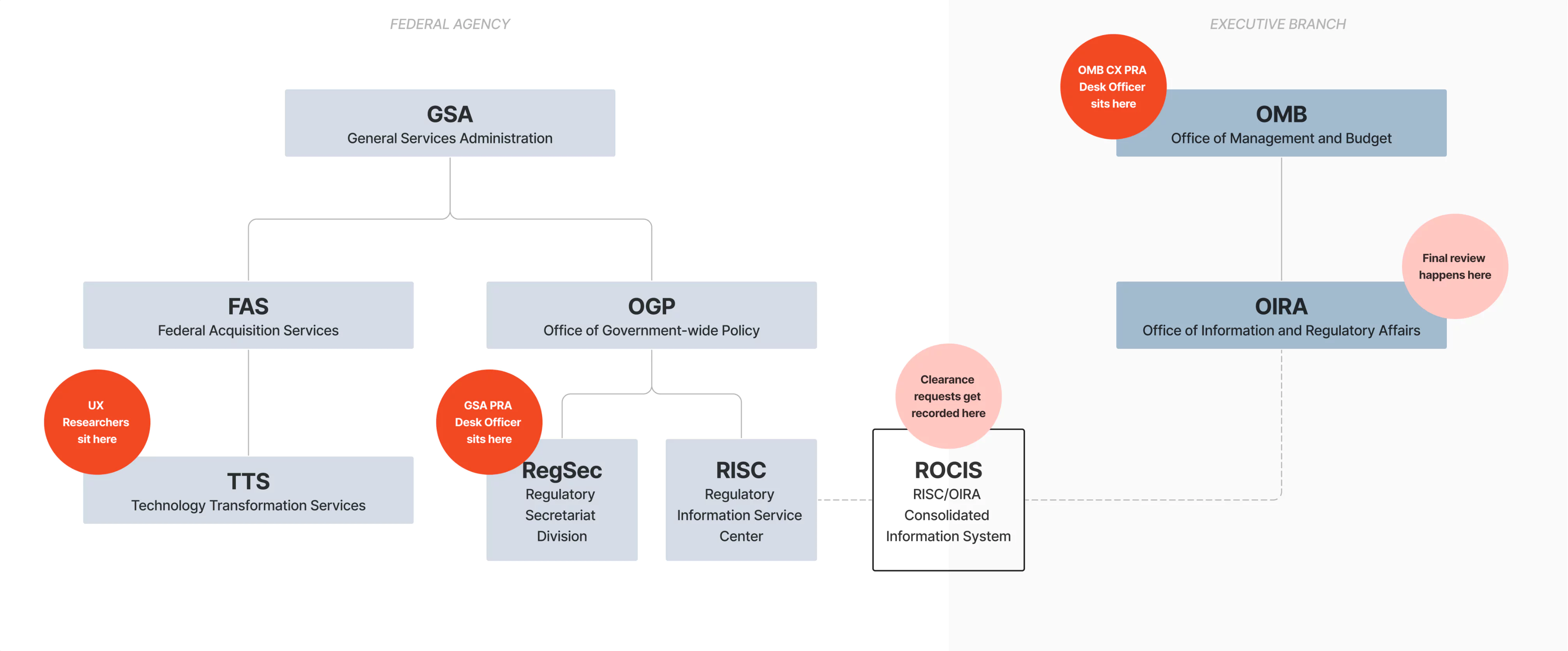Explore PRA
The following information is intended to be a general overview of PRA to provide you with enough background context for implications of PRA here at TTS. The following sections “Find out if you need PRA clearance” and “Get PRA clearance” will provide practical guidance.
What is PRA?
The Paperwork Reduction Act of 1995 (PRA) is a law governing how federal agencies collect information from the American public. It was designed to “ensure the greatest possible public benefit from and maximize the utility of information created, collected, maintained, used, shared, and disseminated by or for the Federal Government” and to “improve the quality and use of Federal information to strengthen decision making, accountability, and openness in Government and society” (44 U.S.C. § 3501).
True to its name, the original intent of the Paperwork Reduction Act is to reduce the amount of government paperwork the public must fill out. It ensures that when we ask the public for information, it's for a good reason and that we're not asking for stuff we don't really need.
Goals of the PRA include:
- Reducing public burden: It prevents the Federal government from collecting redundant information or information that they don't actually need to provide a service.
- Better use of data: It makes sure that the information the Federal government collects is used effectively to make informed policy decisions and improve government services.
- Giving the public a voice: It gives the public a chance to weigh in on how the government is collecting information.
Why does PRA matter at TTS?
TTS is in the business of improving government digital services, and this work involves a lot of user research. PRA governs how federal UX Researchers can collect information from members of the public, so if you're doing user research here at TTS, you need to know the basic principles of PRA, when it may apply to your research activities, and how to get it.
There are several factors that determine when PRA applies or not, and these boil down to WHO you are collecting information from and HOW you collect that information. Remember that the point of the PRA is to protect the public from undue burden associated with information collection, so keep that guiding principle in mind.
Goals of the PRA include:
Anytime you are planning user research as a TTS UX Researcher, you should consider whether your research activities need PRA clearance or not. In addition to the research itself, you may also need PRA clearance for the following activities:
- Recruiting participants
- Making updates to materials that have prior or current PRA clearance
- Translating materials that have prior or current PRA clearance to languages other than English
To learn more, and to find out if you need PRA clearance or not, click here.
In order to get PRA clearance for collecting information, an agency must develop what is called an “information collection request” or ICR. An ICR is a package of documents detailing the proposed information collection that will then be reviewed and approved by OIRA.
There are several different types of PRA clearance processes, designed for different types of information collection activities. The standard process you may have heard about can take up to nine months, but luckily there are other types of clearances that have been designed specifically for improving customer experience via user research.
How does PRA work at TTS?
GSA has several CX-specific clearances in place, most notably the Fast Track (A-11 Section 280) process, which takes 7-14 business days, and was designed for:
- Customer Research (e.g., User Persona and Journey Map Development),
- Customer Feedback (Satisfaction Survey), and
- User Testing of Services and Digital Products
Most qualitative user research done here at TTS will likely be able to get PRA clearance through the Fast Track (A-11 Section 280) process. This process involves working with OMB's CX PRA Desk Officer to build an ICR. Find out more about getting PRA clearance at TTS.
There are three main parties involved in any given PRA clearance process. They are:
- Researcher. This is the person submitting the information collection request.
- Agency-specific PRA Desk Officer(s). They facilitate the submission of the PRA clearance request.
- OIRA reviewer. They have final approval authority over all PRA clearance requests.
In addition, OMB’s CX PRA Desk Officer oversees PRA clearance processes specifically associated with CX (those that use Generic and Fast Track clearances). They help advise researchers about how to build their ICRs and can help facilitate hand-offs between the other parties.
| Person | PRA Responsibilities | When to contact |
|---|---|---|
| [TTS] Researcher (That’s you!) |
| N/A |
| [OMB] CX PRA Desk Officer Todd Rubin |
|
|
| [GSA] PRA Desk Officer Nicole Bynum |
| CC when submitting finalized PRA request package |
| [OIRA] Reviewer |
| You will not need to contact the OIRA reviewer directly |
Where are these people located?
More information
General PRA information
OMB CX Desk PRA guidance
- Customer Experience Collection Central (requires login)

